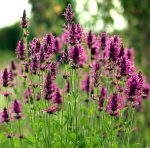 This herbaceous perennial is native to grasslands, meadows, and open woods of Europe, western Asia, and northern Africa and is also known as common hedgenettle and bishopwort. It is a member of the mint family, Labatiae, that also includes basil, sage, and beebalm. Plants grow up 9″ to 3′ tall depending on the variety, and have a hairy stem that is square in cross section and sometimes branched. The dark green oval leaves are up to 5″ long, hairy, coarsely toothed, and have a wrinkled appearance. The tubular red-violet flowers appear in interupted spikes in mid to late summer and are 2-lipped and 3/4″ long. The flowers attract pollinators and are good cut flowers. Although betony has an illustrious past as a medicinial herb it is more popular now as an ornamental for borders and cottage gardens. The genus name, Stachys, comes from the Greek word stachys meaning ear of corn and refers to the inflorescence of a related plant. The specific epithet, officinalis, is the Latin word meaning sold in shops and refers the medicinal value of the plant.
This herbaceous perennial is native to grasslands, meadows, and open woods of Europe, western Asia, and northern Africa and is also known as common hedgenettle and bishopwort. It is a member of the mint family, Labatiae, that also includes basil, sage, and beebalm. Plants grow up 9″ to 3′ tall depending on the variety, and have a hairy stem that is square in cross section and sometimes branched. The dark green oval leaves are up to 5″ long, hairy, coarsely toothed, and have a wrinkled appearance. The tubular red-violet flowers appear in interupted spikes in mid to late summer and are 2-lipped and 3/4″ long. The flowers attract pollinators and are good cut flowers. Although betony has an illustrious past as a medicinial herb it is more popular now as an ornamental for borders and cottage gardens. The genus name, Stachys, comes from the Greek word stachys meaning ear of corn and refers to the inflorescence of a related plant. The specific epithet, officinalis, is the Latin word meaning sold in shops and refers the medicinal value of the plant.
Type: Herbaceous perennial
Bloom: Interupted spikes of tubular, 2-lipped red-violet flowers in mid to late summer
Size: 9″-3′ H
Light: Full sun to partial shade
Soil: Average, medium moist, well-drained; drought tolerant once established
Hardiness: Zones 4-8
Care: Low maintenance
Pests and Diseases:Leaf spot, powdery mildew, Rhizoctonia, rust, Sclerotium, aphids, caterpillars, cyclamen mites
Propagation: Seed, cuttings, division
Companion Plants: Purple coneflower, geranium ‘Rozanne’, golden Marguerita
Outstanding Selections: ‘Hummelo’ (hot pink flowers, 1-2′ tall)
Photo Credit: Wikipedia